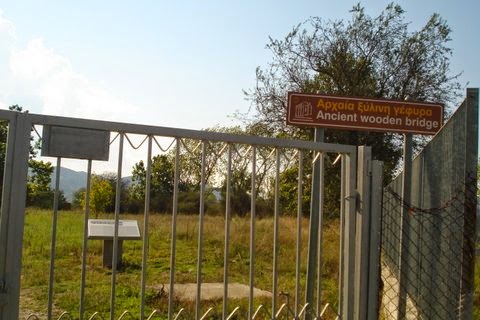On the road to Amphipolis, there stands a massive stone lion. It's exactly like the lion monument left on the battle field of Chaironea in Greece when the Macedonians defeated the Greeks and Thebans, a monument to the dead soldiers. This one has always been considered a funeral monument for one of Alexander's chief generals. It was carried down from its original site by the Romans long after Alexander's time and is now thought to have crowned the massive tomb that has been uncovered in Amphipolis.
I've been to Amphipolis twice before on research trips. On my first trip, just as I was walking past the lion the sky grew dark and a bolt of forked lightening shot down over the hill that was once the city's acropolis. I took it to be an omen, and turned back. On the second trip to Amphipolis, I was exploring where the site of the old fortress used to be on the acropolis hill and trying to figure out how two young boys might escape from there. As I trudged down the dirt road suddenly a snake slithered across the path in front of me. I didn't wait to see if it was a viper. I turned back and called it a day.
Remains of walls, Byzantine period
The site of Amphipolis has been occupied for centuries. Before Alexander's time it was a strategic city and when the Persians passed that way, in the 5th century BCE, they sacrificed 9 girls and 9 boys to the river gods as they passed over the stone bridge heading west on their conquest of Macedonia and Greece. By Alexander's time it was a stronghold and army fortress. The acropolis and town were located between the fork of two rivers and behind it to the north was a lake. The seaport was used for transporting slaves to the gold and silver mines on Mt Pangeon nearby. Alexander's father, Philip II won the mines from the Greeks and financed his campaigns with the spoils. Alexander did too when he took over his father's quest to drive the Persians out of Asia Minor.
View to the sea
Amphipolis is the setting in the last part of SHADOW OF THE LION: BLOOD ON THE MOON and is the setting for the last half of book two, THE FIELDS OF HADES. So I felt it was important to revisit it especially with the excitement of the tomb find. In fact, my novel was published exactly when the announcements were made about the tomb so this has created a great deal of excitement for me in Greece. I took this to be an excellent omen. And perhaps the other two were as well. They were certianly symbolic of events that happen in the novel!
There are more than ancient Macedonian and Greek remains in Amphipolis. After Alexander's time the Romans took over the fortress. Later it was under Byzantine rule. Now, aside from the ruins and the fantastic tomb, it is a small town on the north side of the acropolis hill several miles from the sea.
The first time I went there, I walked from the highway. The second time I took a local bus from the highway. This time, my stay was limited so I decided to hire a taxi. My hotel at Asprovalta arranged this for me. Lucky for me, I had a cab driver who knew the area thoroughly and was only to happy to show me everything he could.
You can't get close to the tomb digs. I was only able to observe it from across the valley. I was told they are digging down from the top to get to the inside of it and it is massive. You can see by the photos that it takes up almost half the hilldside which, in fact, is really a grave mount like the one at Vergina was where the Royal Tombs are located.
We drove around a bit more trying to get as close as possible. The driver showed me various other sites along the way including parts of the old walls, likely Byzantine period, and the place where an ancient wooden bridge once spanned the river.
Amphipolis Museum
There is a new museum at Amphipolis that wasn't there on my last visits. But we didn't have time to stop and look inside. From the museum area you can look out over the valley toward the tomb.
The archaeologists promise that they will reveal soon who they believe occupied the grave. I can't believe it would be Roxana or Iskander as Kassandros hated them. He hated Alexander's mother too and it is more likely she is buried in the royal tombs of Vergina. It definitely wouldn't be Alexander as he was interred in Alexandria, Egypt. So if it isn't the Antipatrides family it is more than for a famous general. Which one though: Antigonos the One Eyed? Lysimichos, who was King of Thrace, Nearchos, admiral of the fleet? Or is it, Laomedon, the one who they believed the lion was dedicated to?
Care to make any bets?
WATCH THESE VIDEOS: www.youtube.com/watch?v=efmPz9iBF1Y
www.youtube.com/watch?v=XHNqhGflskk
www.theamphipolistomb.com/
NEXT: Back to Athens and my book promo tour.















































